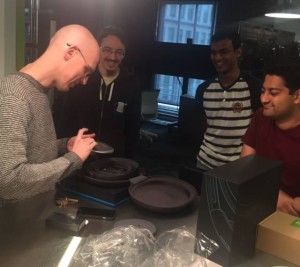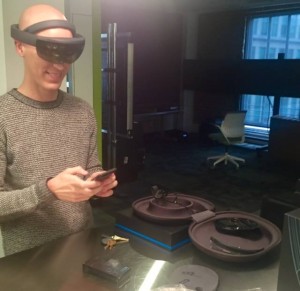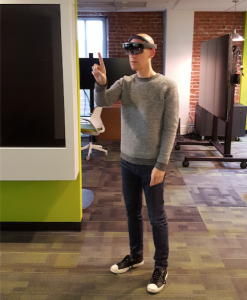We’ve been following the progress of HoloLens quite closely since it was announced, imagining ways we could bring holograms into the experiences and smart spaces we produce. After months of waiting, we finally got the invitation to purchase the dev kit, and just a few days later it arrived! Yes, HoloLens is a real thing, and it’s pretty awesome.


It arrived a day earlier than expected, and we resigned ourselves to a period of lost productivity while we tore it open, set it up, and passed it around the studio.
The unboxing experience was clearly thought through, including beautiful custom packaging, and pleasing textures on the carrying case and the device itself. We of course didn’t bother reading the instructions, but found it easy enough to get it fitted and let Cortana walk through the rather lengthy setup process, which includes fun things like learning the various gestures required to navigate the interface, and mundane things like entering a wifi password on a keyboard hovering in space before you.
We’d read that some users were finding the gestures challenging — you “air tap” in order to “click” on the thing in the center of your field of view — but everyone in the studio was able to jump right in without any instruction. We placed a browser on the kitchen cabinet, a space shuttle hologram on a desk, and a tiger hologram on the floor. We took many selfies.

There are only first impressions so far, but they’re largely positive, and the product seems quite far along for something that’s not even considered released yet. It’s a real Windows device, running real applications, not tethered to a gaming PC on the floor. Gestures are recognized reliably and easily out of the box. The environment is constantly scanned for places to rest holograms on, and it works, and the holograms stay right where you left them. And it’s reasonably comfortable to wear!
 The big limitation of course is the field of view — holograms appear only within a specific rectangle in front of you, and you’re not completely immersed in an experience in the same way as a VR headset. If you wear glasses anyway, it’s kind of like the view through your frames. It’s not really fair to compare HoloLens to Oculus or Vive, though — they’re meant for different types of experiences.
The big limitation of course is the field of view — holograms appear only within a specific rectangle in front of you, and you’re not completely immersed in an experience in the same way as a VR headset. If you wear glasses anyway, it’s kind of like the view through your frames. It’s not really fair to compare HoloLens to Oculus or Vive, though — they’re meant for different types of experiences.
There are obvious applications of HoloLens for Stimulant in the production of guest experiences in places like high-end sales centers or VIP tourism. Where other AR/VR devices are isolating or tethered, HoloLens allows a guest to move around a space, and see things from every angle. Perhaps an observation deck where points of interest are highlighted on the view itself instead of on a touch-screen kiosk. An e-commerce app which lets you purchase artwork for your walls, and shows it to you on the actual wall in front of you. A retail space in which you look at the product you’re thinking about buying, with stats, details, and customization options hovering around.
We’ve only had a short time with the device, but we’re terribly excited to dig in more. Catch more of our explorations on Twitter and Instagram.







